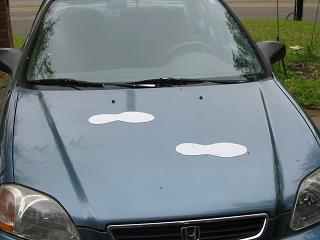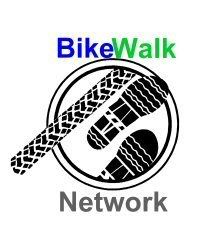Call Street - Bike Lanes or Not?
On January 8, 2007, Florida State University will open a 980 space parking garage on Call Street at Macomb Street. In anticipation of this event, and to facilitate access in and out of the parking deck, Call Street is being converted from a one way (eastbound) street to a two-way street. That much is a done deal.
The question being kicked around now is whether Call Street should have bike lanes or on-street parking. Currently, it is two eastbound lanes and on-street parking. The city has proposed making it one lane each way, removing on-street parking and adding bike lanes. Downtown merchants have revolted. They are screaming that removing any parking from the downtown will hurt their businesses.
Some bike advocates have argued that the street is an important bicycle connection, but bike lanes aren't appropriate on Call Street. They say that street parking will do more to slow traffic and make the corridor safer for cyclists.
The Fix
Here's my conclusion: Leave it alone for now. Make it two lanes, leave the on-street parking. Watch what happens, provide law enforcement on site. How motorists and bicyclists respond to the change in traffic flow will provide feedback for whether bike lanes might be appropriate for the situation. It won't be perfect information, but it will be better information than we have now.
Here's the beauty of doing nothing: It's easy to change. All you have to do is paint new lines on the road. Nothing to plow under or pave. No right of way to purchase or earth to be moved. Just paint. If it isn't working, repaint it.
This only works if we actually watch what happens. I would like to see the city commit some resources to actually monitoring motorist, cyclists and pedestrian behavior and especially bicycle and pedestrian usage in the corridor once the traffic pattern changes. What's the level of demand? What's the level of sophistication of the users? That kind of information will help to answer the question "Should we have bike lanes on Call Street?"
To actually accomplish that the city needs a full-time Bicycle Pedestrian Coordinator. How about it Mr. Mayor?
Enforcement
Whether or not Call Street gets bike lanes, there will be tremendous traffic conflict at the Call Street entrance to the parking deck. When I say conflict, of course I mean mayhem and death. If you have ever seen the college students lining up at the parking decks during peak hours, you can easily predict the clusterf*ck that will arise from this particular location. I can just imagine the line of cars backed up around the corner onto Macomb Street trying to get into the parking deck, while an equal line of cars snakes out of the deck, backed up from the light at Macomb and blocking all traffic on Call Street. Meanwhile a stream of traffic pours out of the garage toward Copeland Street, where they force their way through throngs of pedestrians to escape onto Tennessee Street.
I don't care about any of that, of course. What concerns me is the part about blocking all traffic on Call Street, meaning crosswalks and bike lanes or even bicycle access on the roadway. We have plenty of parking decks in town with inadequate sight distance for drivers to see sidewalk traffic and plenty of others where the sight distance is fine, but drivers block crosswalks anyway because they are selfish and inconsiderate.
So I'm concerned that bicyclists and pedestrians trying to get past the parking deck entrance are going to get hit by inattentive motorists. It's foreseeable. I have predicted it. FSU and the city need to anticipate it and mitigate it. Someone will die there in 2007 without some serious enforcement attention. I recommend posting a cop there at peak times and handing out warnings for anybody who stops in the crosswalk or blocks the road with their car and handing out handcuffs to anybody who hits a bicyclist or pedestrian.
The question being kicked around now is whether Call Street should have bike lanes or on-street parking. Currently, it is two eastbound lanes and on-street parking. The city has proposed making it one lane each way, removing on-street parking and adding bike lanes. Downtown merchants have revolted. They are screaming that removing any parking from the downtown will hurt their businesses.
Some bike advocates have argued that the street is an important bicycle connection, but bike lanes aren't appropriate on Call Street. They say that street parking will do more to slow traffic and make the corridor safer for cyclists.
The Fix
Here's my conclusion: Leave it alone for now. Make it two lanes, leave the on-street parking. Watch what happens, provide law enforcement on site. How motorists and bicyclists respond to the change in traffic flow will provide feedback for whether bike lanes might be appropriate for the situation. It won't be perfect information, but it will be better information than we have now.
Here's the beauty of doing nothing: It's easy to change. All you have to do is paint new lines on the road. Nothing to plow under or pave. No right of way to purchase or earth to be moved. Just paint. If it isn't working, repaint it.
This only works if we actually watch what happens. I would like to see the city commit some resources to actually monitoring motorist, cyclists and pedestrian behavior and especially bicycle and pedestrian usage in the corridor once the traffic pattern changes. What's the level of demand? What's the level of sophistication of the users? That kind of information will help to answer the question "Should we have bike lanes on Call Street?"
To actually accomplish that the city needs a full-time Bicycle Pedestrian Coordinator. How about it Mr. Mayor?
Enforcement
Whether or not Call Street gets bike lanes, there will be tremendous traffic conflict at the Call Street entrance to the parking deck. When I say conflict, of course I mean mayhem and death. If you have ever seen the college students lining up at the parking decks during peak hours, you can easily predict the clusterf*ck that will arise from this particular location. I can just imagine the line of cars backed up around the corner onto Macomb Street trying to get into the parking deck, while an equal line of cars snakes out of the deck, backed up from the light at Macomb and blocking all traffic on Call Street. Meanwhile a stream of traffic pours out of the garage toward Copeland Street, where they force their way through throngs of pedestrians to escape onto Tennessee Street.
I don't care about any of that, of course. What concerns me is the part about blocking all traffic on Call Street, meaning crosswalks and bike lanes or even bicycle access on the roadway. We have plenty of parking decks in town with inadequate sight distance for drivers to see sidewalk traffic and plenty of others where the sight distance is fine, but drivers block crosswalks anyway because they are selfish and inconsiderate.
So I'm concerned that bicyclists and pedestrians trying to get past the parking deck entrance are going to get hit by inattentive motorists. It's foreseeable. I have predicted it. FSU and the city need to anticipate it and mitigate it. Someone will die there in 2007 without some serious enforcement attention. I recommend posting a cop there at peak times and handing out warnings for anybody who stops in the crosswalk or blocks the road with their car and handing out handcuffs to anybody who hits a bicyclist or pedestrian.


